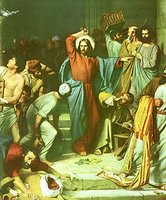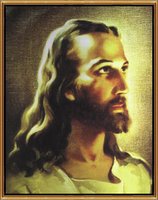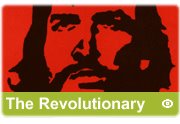Proof of I.D.
- John 2.13-22
3.19-06 DBC

Proof of I.D.
Today’s Scripture presents a hard picture of Jesus: “Jesus put together a whip out of strips of leather and chased them out of the Temple, stampeding the sheep and cattle, upending the tables of loan sharks, spilling coins left and right . . .”
I can imagine Jesus walking into the crowed Temple with his disciples close behind in awe of the magnificent structure (MK 13.1). As he walked and surveyed the scene, his blood began to boil and pace grew faster. He reached into the animal bins and grabbed out strips of leather used for bedding and twisted the leather strips together into a crude whip-like weapon. All of the sudden he explodes with passion and holy rage whipping tables and stampeding animals and flipping over tables and shouting “Get these things out of here stop turning my Father’s house into a market house.”
This is a very different portrait of Jesus than we are use to. It really is a shocking image of a raging, revolutionary, and passionate man; and this image of such a man is the Christ, our Lord.
Some may have a hard time reconciling such an image of Christ with Sunday school and nighttime story images of Jesus that many of us have grown up with.

It is easier to picture the serene Christ tenderly caring for a lamb or eloquently teaching crowds from a hill side or carefully reaching out to restore sight to the blind or compassionately touching the forehead of a dead little girl and raising her back to life or picking up a little child saying “for such is the Kingdom of God;”
but to picture a revolutionary angry Jesus is harder to imagine and harder to comprehend.
 But all of the above is indeed that same man, a man full of love and zeal and feelings and emotion and humanity and divinity all at the same time. His anger and humanity, however, was without sin or malice, it was a holy anger and righteous indignation.
But all of the above is indeed that same man, a man full of love and zeal and feelings and emotion and humanity and divinity all at the same time. His anger and humanity, however, was without sin or malice, it was a holy anger and righteous indignation.
The Passover was the biggest event of the year at the grandest and most important Jewish location of Jerusalem (The Temple).
The Passover was an annual feast celebrating when the angel of death passed-over the lamb blood sprinkled doorways of the Jews in Egypt (Exodus 12). Jewish people traveled to the Temple in Jerusalem for the Passover from diverse and widely spread out regions and other countries; in fact, attending the Passover was mandatory for every Hebrew adult male within fifteen miles of Jerusalem. It’s been estimated that as many as two and quarter million of Hebrews, at any given Passover, were in Jerusalem to celebrate (Barclay).
The Temple was like the White House of Israel. “The Temple was the organizing center of Jewish life in the first century. It was the center of government [albeit brokered by Rome at this time], judicial law, religious life, and taxation. It set the moral, religious, and political, tone of the country.” (Burge, 99-100)
It was huge magnificent structure, and to this point had been still underway for the past 46 years (It would not be complete until ca 66 AD and then would be ironically- prophetically- burned down in 70 AD.).
So what was the deal? What was the problem? What was it that sparked off Jesus’ fiery anger?
Let me point out a couple of things and suggest some other points that served to fuel the anger of Christ that day in the Temple:
The traveling Pilgrims were being exploited. They could pay their Temple tax only in the Temple coinage (Jewish gold shekel). Moneychangers were set up in the outer court to change the pilgrim’s foreign currency into Jewish coinage that could only be used in the Temple. The moneychangers were making about a days wages for the transaction.
In addition to the moneychangers set up and conducting their very lucrative trade pilgrims were to buy animal offerings (if they wanted to offer sacrifice) only form Caiaphas’ Temple priests (the sacrifice animals had to be unblemished). The Temple priests were charging an overly outrageous price for sacrificial animals and they were not accepting sacrifices from outside the Temple. The pilgrims were being fleeced!
There are some other factors that I think Jesus’ anger was directed at:
1. The Scripture repeatedly says, “animal sacrifice was completely irrelevant.” (Barclay) Therefore, the temple traditions and sacrifices were irrelevant.
A. “What to me is the multitude of your sacrifices? Says the Lord; I have had enough burnt offerings of rams and the fat of fed beasts; I do not delight in the blood of bull, or lambs, or goats . . . Bring no more vain offerings.” (Isa 1.11-17)
B. “For in the day that I brought them out of the land of Egypt, I did not speak to your fathers of command them concerning burnt offerings and sacrifices.” (Jer 7.22)
C. "For thou hast no delight in sacrifice; were I to give a burnt offering, thou wouldst not be pleased.” (Ps 51.16)
2. The other Gospel accounts explain that the Temple had been intended to be a house of Prayer and not market commerce. (Matt 21.13; Luke 19.46)
3. Also, the Temple and God’s presence was to be a house of prayer for all nations (LK 19.46). The Temple priests had sectioned off the temple into 7 courts. (Utley) Such courts included an outer court for Gentiles, then the court of women (Jewish women), then the court of Jews (men), then the court of priests. The courts were used to keep people out and excluded from God. “The Temple authorities and Jewish traders were making the court of gentiles into an uproar and a rabble where no man could pray. The lowing of the oxen, the bleating of sheep . . . the rattle of coins, the voices raised in bargaining disputes- all of these combined to make the Court of Gentiles a place where no [one] could worship. The conduct of the Temple court shutout the seeking Gentile from the presence of God.” (Barclay)
So what can we say in away of application and contemplation for us today about all of this?
First, I think that we must consider the multiple faces of Christ. Yes he is the good shepherd and the manifestation of God’s love . . . He is also the Lion of Judah and the man who one day went flipping over tables and cracking a whip scattering people and animals all over the Temple, all of this in the same Jesus.
* We too readily accept the most comfortable notion of Christ and we too often do not willingly acknowledge how awesome and unlimited Christ truly is.
* We like to think Christ is like us:
That he looks like us.
Thinks like we think.
Votes the way we vote.
That he is of the same denomination and mindset as we are.
* And what if Christ came into our temple today?
Would he find a welcoming place to all people (all races and denominations)?
Would he find a place of prayer or a place of empty and exclusive tradition?
It’s interesting that he received no arguments for his actions that day . . . In response (knowing that his actions were justified) all that the Temple authorities could ask was, “What credentials can you present to justify this? Who are you? Where is your proof of I.D.?
Jesus says that his proof of I.D. was this prophetic utterance, “Tear down this Temple [his body] and in three days I’ll put it back together.” That was his authority.
* What of our zeal for the things of God? Is the inclusion of his people, the purpose of prayer, and significance of his death and resurrection our passionate proclamation as well?
Amen.


 But all of the above is indeed that same man, a man full of love and zeal and feelings and emotion and humanity and divinity all at the same time. His anger and humanity, however, was without sin or malice, it was a holy anger and righteous indignation.
But all of the above is indeed that same man, a man full of love and zeal and feelings and emotion and humanity and divinity all at the same time. His anger and humanity, however, was without sin or malice, it was a holy anger and righteous indignation.
1 Comments:
God is good, dangerous but good. This is a very different picture than what we are usually told about Jesus.
Who would crucify a Mr. Rogers or a Captain Kangaroo? Phil Yancey "The Jesus I never knew."
Post a Comment
<< Home